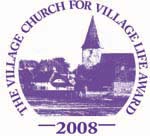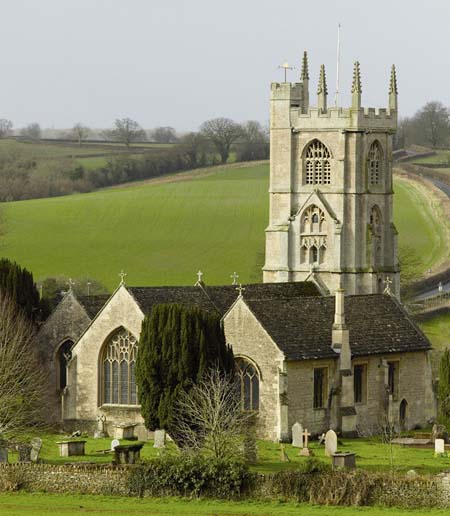Village Church for Village Life Finalists
We reveal the shortlist of six churches who are vying for the £10,000 award, generously donated by the Mercers’ Company


The Village Church for Village Life Award, launched in December by Sir Roy Strong, has elicited an extraordinary response. Eighty nominations have come in from across the country for churches that have successfully adapted themselves to serve the wider needs of the community in which they stand. This selection of finalists was conducted on the basis of information provided by the parishes and congregations themselves. Nominations were received for buildings and projects of every kind. At one end of the spectrum is the great abbey church of Dorchester-on-Thames in Oxford-shire, which has been adapted with exemplary sensitivity in a multi-million-pound project to a museum space and create new facilities. At the other is the tiny late-19th-century corrugated-iron mission church of St Mary s in Co Durham, where, at almost no cost, a small congregation has unbolted the pews and created the only youth facilities for miles around.
The sheer diversity of uses to which churches have been put is also remarkable. St Bega s, Eskdale, Cumbria, and the church of St Mary and St Radegund, Whitwell, Isle of Wight, both double up as post offices for their local communities. St Giles, Shipbourne, in Kent, hosts a highly successful weekly market, created by laying boards across the pews. It allows local farmers to sell their produce and attracts considerable custom. In similar fashion, the light and airy interior of St Nicholas, Salthouse, Norfolk, has been transformed into an exhibition space by the simple yet effective means of installing bars for hanging contemporary art. It now receives more than 5,000 visitors a year.
The overall picture that these and all the other nominated projects paint is very encouraging. They show what an amazing quantity of work is taking place in English parish churches, and the heroic dedication, invention and determination of village communities. This is in stark contrast to what might be expected, given the talk of dwindling congregations and wider rural decline. Individually, they are inspiring examples of how the future of some churches can be assured. In selecting a shortlist of finalists from such an impressive body of nominations, the quality and sensitivity of any physical alterations to the fabric became very important. So, too, did the financial and practical constraints imposed by the size of the local community.
Over the summer, Sir Roy Strong, Candida Lycett-Green, Fred Hohler, Marcus Binney and Lady Eatwell will visit all six finalists. The winner will be announced in the autumn.
* St Peter s, Whatcote, Warwickshire
At Whatcote, a village of 70 houses, it was felt that the 12th-century parish church would be of more benefit to the local area if the interior was simplified. In 2004, this idea was realised. To clear space, the pews were removed and the font and organ re-sited. An ingenious and discreet kitchen in a cupboard was designed for the back of the church. Corresponding to this was a cupboard vestry. The tower was also altered and now houses a lavatory. A heating system, an essential addition, had been installed in 1999. The total cost of the project was about £100,000, £85,500 of which came from grants, with the difference made up by fundraising and donations from the village.
The building is now used regularly by the village and surrounding area for talks, quiz evenings, concerts, courses, film screenings, meetings and private parties.
Sign up for the Country Life Newsletter
Exquisite houses, the beauty of Nature, and how to get the most from your life, straight to your inbox.
* St Margaret s, Thorpe Market, Norfolk
Built in 1796, St Margaret s is one of 10 churches in a single benefice and serves a community of 300 people. By 1997, a dwindling congregation and no fixed income meant that the church faced imminent closure. Half the parish council resigned. The remainder decided that the church might have a future as an art and music venue. An appeal to the local community raised an initial £14,000 of the £43,000 needed for the project, and fundraising made up the difference.
A disabled lavatory and a modern kitchen were installed in an extension erected on the site of a former coach house attached to the church. This arrangement satisfied the restrictions of adapting the church fabric, which is listed Grade II*. Meanwhile, the choir stalls were removed from beyond the chancel screen to create space for a collapsible stage.
Today, the church is used by the local community as a base for the village folk band and choir, for film screenings and for parties. The building also hosts concerts and exhibitions by various community groups. Some 5,000 visitors a year now pass through a church that once had a congregation of fewer than five. Following the increase in demand for the building, an area of land was bought to make a car park, which is also home to several recycling banks for the village. These banks contribute more than £1,000 to the church s annual £6,000 running costs.
* St Mary s, Slaugham, West Sussex
At the centre of a parish of four villages, the church at Slaugham already had a strong congregation. However, its parishioners felt that its lack of facilities limited the use of the church by the wider community. In addition, the sight lines for the liturgy were poor, and the steps in the church were problematic for the elderly and disabled.
As a first phase of work, a small extension was built to house a disabled lavatory. The second phase, completed at the end of last year, saw the removal of the Victorian pews replaced with comfortable chairs and the installation of a new, level floor of Portland stone. A meeting room, which also includes a small kitchen, has been created, and is separated from the rest of the church by soundproof glass. The £600,000 cost of the project was entirely funded by the congregation and local community.
The full possibilities of this recent transformation are still being explored, but the space is already used for concerts and drama productions, and by the local school. Future plans include exhibitions, arts-and-crafts workshops, adult-education classes and indoor sports activities. The meeting room, which the local residents group can use free of charge, is already in regular use.
* St Peter s, Worfield, Shropshire
St Peter s, Worfield, serves a community of about 2,300, distributed across an unusually large parish of four villages and 20 or so hamlets. The oldest part of this sizeable church dates from the 12th century, and most of the furniture, including the pews, dates from the 1860s. By the Millennium, it was clear that there was a need for somewhere for the local community to meet both socially and formally, and that the church could serve this role if provided with basic amenities. These were installed in a structure erected across the west end of the building.
The budget was £400,000, £40,000 of which came from grants, and the rest was raised from donations and fundraising through an initiative known as Faith in the Future. Several architects were approached, and the final design passed after consultations with relevant conservation bodies and with the villagers.
Whereas St Peter s was previously used for an hour a week, the church is now the venue for a senior-citizens lunch club every month, a weekly parent and toddlers group, an annual children s holiday club, a monthly men s breakfast group, and is used by the Worfield and Rudge Parish for its monthly meetings. There is no charge for using the space. Instead, anonymous donations are encouraged.
* St Philip and St James, Norton St Philip, Somerset
In common with many rural villages in recent years, Norton St Philip has seen the loss of its shops and post office. Moreover, the village hall was not an appropriate or economic venue for small gatherings and events.Therefore, it was decided to develop the church as a new focus for the village. In the north aisle, the pews were removed and replaced by a free-standing and separately heated two-storey glass-and-oak structure called The Hub, which provides a meeting room, kitchen, lavatory and vestry. The area in front of the structure has been carpeted to create a flexible space.
The total cost of the project was £175,000, £22,000 of which came from the diocese of Bath and Wells and £25,000 from the church s own reserves. The majority of the remainder came from a series of fundraising events including suspending the vicar in a glass box in the church for a day, a stunt that generated £35,000 donations, and interest-free loans from parishioners. As well as providing a venue for an estimated 300 village-related meetings a year, The Hub allows the church to be used regularly by a wide variety of groups, from mothers and babies to a 50-strong youth club. In addition, the catering facilities and flexible space have encouraged concerts and exhibitions to take place, and there is a monthly coffee morning and produce stall, a lifeline for the older people in the village.

The exterior of St Philip and St James: inside is The Hub, which provides a meeting room, kitchen, lavatory and vestry
* St Faith, Hexton, Hertfordshire
With a regular congregation in a village of less than 200, this church raised funds for essential re-roofing work in 1994. At the same time, the village hall was deemed unusable, so there was no longer a communal space available in the parish. The large nave in the church seemed a possible alternative, and it was decided to segregate the chancel from the nave. The latter forms a separate hall, although the spaces can easily be rejoined for larger services. A kitchen and disabled lavatory were installed and a new wooden floor laid down throughout. The project, which was completed in 2004, cost £140,000, the majority of which came from fundraising and from a number of grants.
The new nave area, known as St Faith s Community Centre, is now used daily by a playgroup, a youth club and by Hexton Primary School, which previously had no hall for PE, drama and music. This is in addition to individual events such as fashion shows, concerts and a farmer s market. A separate management committee works with the Parochial Church Council (PCC) to run and maintain the centre and its lettings, with first choice given to residents or school parents. The project is self-sustaining the regular village user groups provide a steady income week by week, and the lettings for other events make up the balance.
Country Life is unlike any other magazine: the only glossy weekly on the newsstand and the only magazine that has been guest-edited by HRH The King not once, but twice. It is a celebration of modern rural life and all its diverse joys and pleasures — that was first published in Queen Victoria's Diamond Jubilee year. Our eclectic mixture of witty and informative content — from the most up-to-date property news and commentary and a coveted glimpse inside some of the UK's best houses and gardens, to gardening, the arts and interior design, written by experts in their field — still cannot be found in print or online, anywhere else.
-
 Rodel House: The Georgian marvel in the heart of the Outer Hebrides
Rodel House: The Georgian marvel in the heart of the Outer HebridesAn improving landlord in the Outer Hebrides created a remote Georgian house that has just undergone a stylish, but unpretentious remodelling, as Mary Miers reports. Photographs by Paul Highnam for Country Life.
By Mary Miers
-
 380 acres and 90 bedrooms on the £25m private island being sold by one of Britain's top music producers
380 acres and 90 bedrooms on the £25m private island being sold by one of Britain's top music producersStormzy, Rihanna and the Rolling Stones are just a part of the story at Osea Island, a dot on the map in the seas off Essex.
By Lotte Brundle